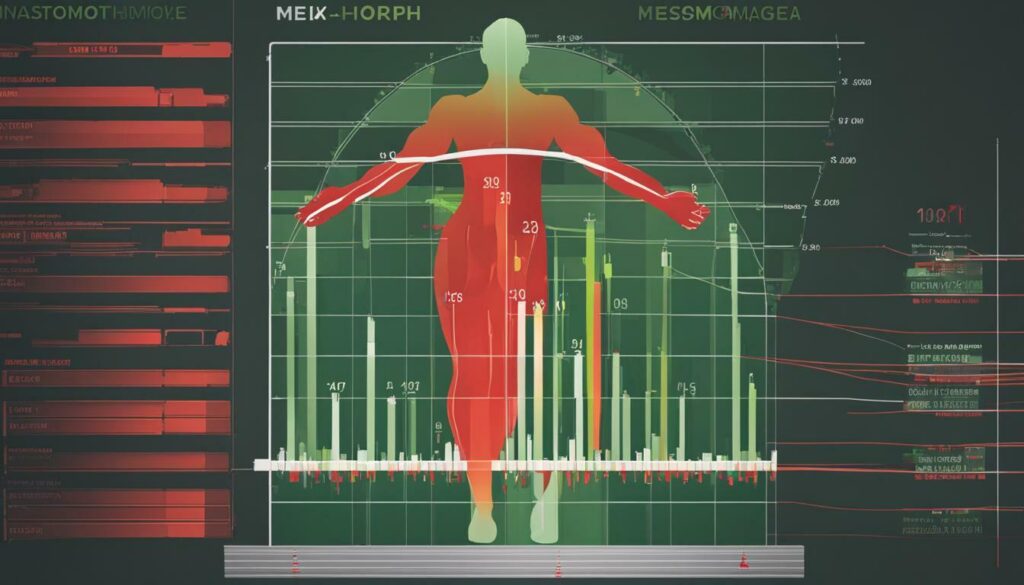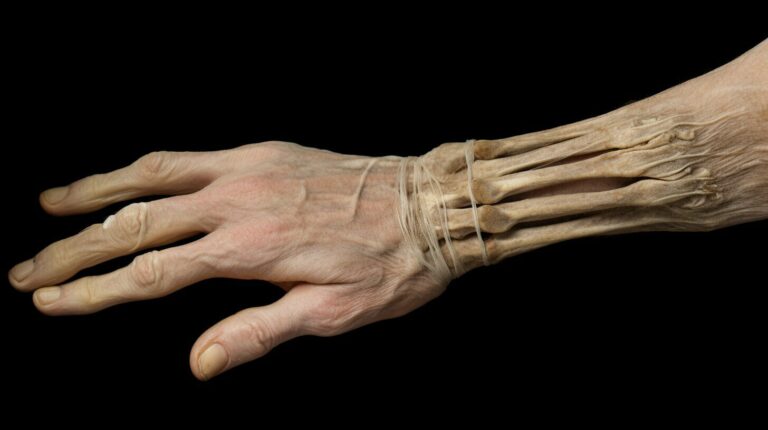Am I Mesomorph or Endomorph?
Determining your body type is crucial for tailoring your diet and exercise routines to achieve optimal results. By understanding whether you are a mesomorph or endomorph, you can gain valuable insights into your body composition and make informed choices to support your health and wellness journey.
To assess your body type, you can take a somatotype quiz and analyze various factors that define different body types. This analysis considers characteristics such as your frame size, muscle development, and fat distribution. By understanding these distinctions, you can better understand how your body responds to nutrition and exercise.
Knowing whether you are a mesomorph or endomorph can guide you in optimizing your health and fitness goals. Each body type has unique traits that influence how you respond to different training and dietary approaches.
It’s important to note that body types are general classifications and individuals can fall somewhere on a spectrum between the different types. You may also identify as a hybrid body type, such as an ecto-mesomorph or meso-endomorph, which combines characteristics from two primary types.
- Determining your body type is essential for customizing your diet and exercise routines.
- Mesomorphs have a moderate-size frame and are genetically inclined to build muscle.
- Endomorphs have a medium-to-large bone structure and struggle with weight loss.
- Ectomorphs are thin and lean with difficulty gaining muscle or body fat.
- Understanding your body type can inform your nutrition and training choices for optimal results.
Different Body Types: Mesomorphs and Endomorphs
Mesomorphs and endomorphs have distinct physical traits that set them apart from each other. Understanding these differences can provide valuable insights into how our bodies are uniquely designed and how they respond to various forms of exercise and nutrition.
Let’s start by looking at mesomorphs. These individuals have moderate-size frames, wider shoulders, and a narrow waist. Mesomorphs are often described as naturally athletic and tend to build muscle easily. They have a higher metabolism, making it easier for them to stay lean and maintain their weight. With proper training and diet, mesomorphs can achieve impressive results in terms of muscle growth and body composition.
On the other hand, endomorphs have a medium-to-large bone structure and carry excess weight, particularly in the lower abdomen, hips, and thighs. Endomorphs have a slower metabolism, making it more challenging for them to lose weight. However, with the right approach to nutrition and exercise, endomorphs can achieve their health and fitness goals. It’s important to note that endomorphs can also build muscle, but they may need to focus on losing excess body fat to reveal their muscle definition.
It’s worth mentioning that there are also hybrid body types that possess characteristics from two primary types. Ecto-mesomorphs have a combination of traits from ectomorphs and mesomorphs, while meso-endomorphs and ecto-endomorphs combine characteristics of mesomorphs with endomorphs. These hybrid body types may present unique challenges and advantages when it comes to fitness and weight management.
“Understanding your body type is the first step towards optimizing your health and wellness journey.”
Ultimately, it’s important to remember that body types are general classifications, and individuals can fall somewhere on a spectrum between the different types. Identifying your body type can help guide your nutrition and training choices, allowing you to tailor your approach to achieve the best possible results for your unique physique. By understanding your body’s natural tendencies and potentials, you can make informed decisions to optimize your health and wellness journey.

- Mesomorphs have moderate-size frames, wider shoulders, and a narrow waist, making them naturally athletic and capable of building muscle easily.
- Endomorphs have a medium-to-large bone structure and tend to carry excess weight in the lower abdomen, hips, and thighs. They have a slower metabolism, making weight loss more challenging.
- Ecto-mesomorphs, meso-endomorphs, and ecto-endomorphs are hybrid body types with a combination of traits from two primary body types.
- Understanding your body type can help guide your nutrition and training choices to optimize your health and wellness journey.
| Body Type | Physical Traits | Metabolism |
|---|---|---|
| Mesomorph | Moderate-size frames, wider shoulders, narrow waist | Higher metabolism, easier to stay lean |
| Endomorph | Medium-to-large bone structure, excess weight in lower abdomen, hips, and thighs | Slower metabolism, harder to lose weight |
Assessing Your Body Type: Body Composition Analysis and Quiz
To determine whether you are a mesomorph or endomorph, you can analyze your body composition and take a somatotype quiz. Body composition analysis involves measuring the proportion of fat, muscle, and bone in your body. This analysis provides valuable insights into your overall health and fitness level, as well as your body type.
One common method of body composition analysis is the use of specialized equipment such as bioelectrical impedance machines, which measure the resistance of your body tissues to electrical currents. This helps determine the percentage of body fat and muscle mass you have. Another method is dual-energy X-ray absorptiometry (DEXA), which provides a more detailed assessment of your body composition, including bone density.
In addition to body composition analysis, you can also take a somatotype quiz to further assess your body type. These quizzes typically consist of a series of questions about your physical characteristics and how your body responds to exercise and diet. By answering these questions honestly, you can gain a better understanding of whether you lean more towards being a mesomorph or an endomorph.
It’s important to note that body types are not definitive categories, but rather general classifications. Most individuals fall somewhere on a spectrum between the different types. For example, some people may have characteristics of both mesomorphs and endomorphs, making them a hybrid body type like ecto-mesomorphs, meso-endomorphs, or ecto-endomorphs.
By analyzing your body composition and taking a somatotype quiz, you can gain valuable insights into your body type and use this information to inform your nutrition and training choices. Understanding your body type can help you tailor your diet and exercise plan to optimize your health and fitness journey. Remember, everyone’s body is unique, and what works for one person may not work for another. It’s important to listen to your body and make choices that support your individual needs and goals.
Sample Somatotype Quiz
Below is a sample somatotype quiz to give you an idea of the types of questions you may encounter:
- Are you naturally muscular or lean?
- Do you gain weight easily, especially in your lower abdomen, hips, and thighs?
- Are your shoulders broader than your waist?
- Do you have a difficult time gaining muscle or body fat?
- Are you naturally thin and lean?
Remember, this is just a sample quiz. Online resources can provide more comprehensive quizzes for a more accurate assessment of your body type. Take your time and answer the questions honestly to gain a better understanding of your unique body composition and potential body type.

Please note that the above image is for illustration purposes only and may not reflect the actual body composition analysis process.
Once you have determined your body type through body composition analysis and a somatotype quiz, you can use this information as a guide to make informed choices about your nutrition and training. Remember, it’s always a good idea to consult with a healthcare professional or certified trainer to develop a plan that best suits your individual needs and goals.
Now that you have a better understanding of how to assess your body type through body composition analysis and a somatotype quiz, you can move on to the next section to learn how to optimize your health and fitness journey based on your specific body type.
Knowing your body type can help you make informed decisions about your diet and exercise routines, maximizing your overall health and wellness. When it comes to body type analysis and classification, there are various categories, including meso-endomorphs, ecto-endomorphs, and ecto-mesomorphs, each with its unique characteristics. Understanding where you fall on the spectrum can provide valuable insights into tailoring your nutrition and training choices for optimal results.
If you identify as a meso-endomorph, you have a medium-to-large bone structure and carry excess weight in the lower abdomen, hips, and thighs. It may be more challenging for you to lose weight, but with the right diet and training approach, it’s definitely achievable. Focus on a balanced diet with a slight caloric deficit and incorporate both cardio and strength training into your fitness routine. This combination will help you build lean muscle while burning excess body fat.
On the other hand, if you classify as an ecto-endomorph, you have a thin and lean body with small joints but struggle to gain muscle or body fat. Your focus should be on consuming a nutrient-dense diet with an adequate calorie surplus to support muscle growth. Additionally, engage in resistance training to stimulate muscle development and incorporate compound exercises, such as squats and deadlifts, to target multiple muscle groups.
For those who fall into the category of ecto-mesomorph, you have a combination of characteristics from both ectomorphs and mesomorphs. This means you may have a moderate-size frame, wider shoulders, and a narrow waist. Your body may respond well to both strength and endurance exercises, so incorporate a variety of workouts into your training routine to maintain a balanced physique.
Remember, while body types provide a general classification, individuals can fall somewhere on a spectrum between the different types. It’s important to pay attention to how your body responds to different foods and exercises and make adjustments accordingly. Consulting with a nutritionist or personal trainer who specializes in body type analysis can also provide tailored guidance and support on your health and fitness journey.
FAQ
Am I Mesomorph or Endomorph?
To determine whether you are a mesomorph or endomorph, you can take a quiz that assesses your body type based on various factors. The quiz takes into account characteristics such as body frame, weight distribution, and muscle-building potential.
What are the characteristics of Mesomorphs and Endomorphs?
Mesomorphs have moderate-size frames, wider shoulders, and a narrow waist. They are genetically predisposed to build muscle and have a higher metabolism. Endomorphs, on the other hand, have a medium-to-large bone structure and carry excess weight in the lower abdomen, hips, and thighs. They tend to have a slower metabolism and may struggle with losing weight.
What if I have characteristics of both Mesomorph and Endomorph?
Some individuals have a combination of characteristics from two primary body types. Ecto-mesomorphs display traits of both ectomorphs and mesomorphs, while meso-endomorphs show characteristics of both mesomorphs and endomorphs. Ecto-endomorphs exhibit aspects of both ectomorphs and endomorphs. These hybrid body types exist on a spectrum and can have unique characteristics.
How can understanding my body type help me?
Understanding your body type can inform your nutrition and training choices. For example, mesomorphs may benefit from a higher protein intake to support muscle growth, while endomorphs may need to focus on portion control and a balanced diet to manage weight. By tailoring your approach to your body type, you can optimize your health and wellness journey.






